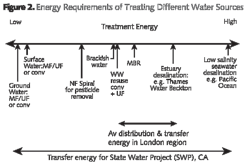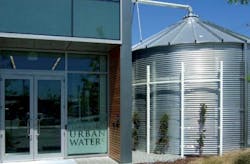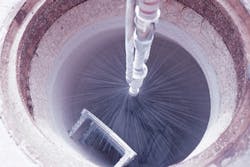Consultation has ended on a policy document that could impact on future wastewater projects in England. How could this affect London's ambitious yet controversial 20 mile wastewater tunnel project? Lis Steadman speaks to the industry to find out more.
Consultation has now ended on one of the most significant Government policy documents to hit the wastewater industry for some time in England. The Wastewater National Policy Statement (NPS) is described as a "framework document for planning decisions on nationally significant wastewater infrastructure". To give some idea of the size and scope, the two projects individually named in the paper are Thames Water's Thames Tunnel (part of the Thames Tideway scheme) and its proposed massive new Deephams wastewater treatment works.
Large Scale
The document covers truly major projects – new plants of over 500,000PE or alterations to plants that will take the existing works by more than 500,000PE over this level. Observers will immediately realise that the Thames Tunnel does not fit this description. However, the government stated an intention that it should be included for consideration at this national level "because of its national significance" – a view that of course could equally apply to other major tunnel schemes in future.
The NPS, the documentation suggests, has been put ahead of the requirements of other legislation such as the Habitats Directive on the basis of Imperative Reasons of Overriding Public Interest (IROPI) – a case the government is still arguing. It recognises that major schemes could well adversely affect sites under the Habitats Directive, but that there is no better way to respect their integrity and deliver the plan objectives. These are to ensure no further deterioration of surface water quality as required by the Water Framework Directive. This, and the Urban Waste Water Treatment Directive obligations, are treated as paramount.
It also has to be borne in mind that the document only covers England – Scotland, Northern Ireland and Wales have their own planning systems. Key points of the new document are its assertion that new wastewater infrastructure is essential, and that demand for new infrastructure is likely to increase for a variety of reasons including future legislation, population growth and urbanisation, climate change, and the requirement to replace ageing infrastructure.
Green infrastructure
SUDS (sustainable drainage systems) are also given significant positive mention, though the Chartered Institution of Water and Environmental Management (CIWEM) believes that not enough has been made of the opportunity to promote these.
Dr Tim Evans, chair of the institution's wastewater management panel notes that: "We've been looking at controlling rainwater at source, at green infrastructure, green roofs, and we feel this is a missed opportunity. We have woken up too late - it has been done in other countries but not this one."
He adds that at the panel's last meeting there was discussion of "gold plating" compliance issues by opting for spot rather than composite sampling of discharges. "Our rivers are healthier than at any time since the Industrial Revolution but we are not spending on sewers. It is misdirected spending", he adds.
The NPS "will not help" he says, noting that he does not believe Defra has "woken up" to SUDS. "They are currently only looking at them for new developments," he explains.
Welsh Water, determined to be an exemplar in this field, struggled to get its demonstration green infrastructure projects into AMP 5, he claims. "They wanted to do a much bigger programme but Ofwat insisted it had to be linked to existing flooding," he notes.
His view is that neither Ofwat nor Defra is aware of what can be achieved through many small elements of green infrastructure. "There is a lack of awareness and training – there is a perception that SUDS are about open fields and big things. But if you go to Chicago and Portland you can see that it can be about a lot of little things. These are city centres and inevitably crowded. Cycling round London you can see so many missed opportunities, for instance for rain gardens to slow down the rate of runoff."
Rain gardens could be used as traffic calming measures, he suggests, and as an extra benefit would help reduce the urban "heat island" effect. The problem, he suggests, is that "it doesn't cost enough to discharge rainwater so there is no incentive to reduce".
After as little as 2mm of rainfall, London's Victorian sewers, which capture both sewage and rainfall, overflow into the Thames River from 57 combined sewer overflows
Had London gone down the road of installing green infrastructure 20 years ago when work on these first started, the Thames Tunnel might have been a less pressing priority, he suggests. "The Thames Tunnel will not stop property flooding. It will just stop CSO [combined sewer overflows] discharges. If sewage gets down to the interceptors and their capacity gets exceeded, the CSOs will work. Control at source would prevent the wastewater getting to the CSOs."
He concludes: "We need to be putting less surface water down drains and looking after the sewers we have got. For a long time we have been saying we are not doing either very well."
Climate change impact on sewer overflows
The industry itself is more skeptical about the possible benefits of demand reduction and SUDs, seeing the NPS predictions as overly optimistic and not supported by the evidence. For instance, the assumption that reducing household water consumption could result in a 10% reduction in discharges to the sewer system is seen as unlikely. For SUDS to become common is also viewed as a long-term prospect.
Regardless, the NPS states that climate change is a key driver for new wastewater systems, noting that "without further investment in sewerage systems, we can expect to experience more frequent overflows from CSOs which could potentially lead to water quality and flooding problems if adequate investment in sewage systems is not made".
Work from UKWIR, which facilitates collaborative research for UK water operators, on the issue concluded that existing networks would need to be extensively modified to deal with the long-term impacts of climate change. The paper notes: "Government expects that other options will not always be able to prevent impacts of intermittent discharges from CSOs and that new infrastructure projects will be needed to address them."
Better treatment may also be required if river flows reduce, which is possible in some parts of the country. Despite all of the demand management opportunities, the paper notes that these will not be sufficient to significantly reduce the need for increased future wastewater treatment capacity. Large scale infrastructure, therefore, is likely.
Project Profile: Thames TunnelWHY: After as little as 2mm of rainfall, London's Victorian sewers, which capture both sewage and rainfall, overflow into the Thames River from 57 combined sewer overflows. This happens about 50 times a year. Without further action, the 39 million tonnes of sewage already discharge into the Thames per year could increase to 70 million tonnes.
WHERE: The width of three London buses, the sewer tunnel would run upto 20 miles from west to east London, up to 75 metres below ground (see map on page 36). It will connect the 34 most polluting sewer overflows. At its most eastern point, wastewater will then go three ways; Lee Tunnel at Abbey Mills, east to the Beckton Sewage Works or South East to Greenwich.
COST & FUNDING: £3.6 billion. Average consumers bills will rise by more than £1 a week by 2018 to fund the project.
SIMILAR INTERNATIONAL PROJECTS? Yes, Singapore's S$3.65 Deep Tunnel Sewerage System (DTSS) consists of two large, deep tunnels crisscrossing the island, two centralised water reclamation plants, deep sea outfall pipes and a link sewer network. Split into two phases, the first phase completed in 2008 comprises 48km (29 miles approx.) long tunnel running from Kranji to Changi, a centralised water reclamation plant.
The paper also notes the impracticality (and cost) of separating the UK's combined sewer systems, and of using a decentralised approach to wastewater treatment in major conurbations. The industry welcomes the paper's recognition that upgrading the existing drainage systems to current standards is unlikely to be cost beneficial, and while supporting the conclusion (2.4.4) on cost incentives for trade effluent, feels that the need for new wastewater infrastructure will continue in most circumstances.
Future design
The NPS also sets out criteria for good design for wastewater infrastructure, noting that it is "about ensuring attractive, usable, durable and adaptable places and contributing to sustainable development. It says: "The IPC [Infrastructure Planning Commission] needs to be satisfied that wastewater infrastructure developments are sustainable and, having regard to regulatory and other constraints, are as attractive, durable and adaptable (including taking account of natural hazards such as flooding) as they can be. In so doing, the IPC should satisfy itself that the applicant has taken into account both aesthetics and functionality (including fitness for purpose)."
However, the industry fears these criteria may compromise the key requirements that they themselves have for facilities to be functional, accessible and to operate safely, and that they could increase customer costs disproportionately. The NPS also looks at generic risks such as flooding, noting that the aim of planning policy is for all sources of flooding to be taken into account to avoid inappropriate development in areas at risk of flooding. Where new wastewater infrastructure is needed, the NPS notes, "policy aims to make it safe without increasing flood risk elsewhere and where possible, by reducing flood risk overall".
There is a "sequential test" approach to developing in areas at risk of flooding, with preference given to locating projects in Flood Zone 1 (if need be), then if no reasonably available site exists there, the development can be sited in Flood Zone 2. Should neither produce a usable site, essential infrastructure (including the nationally significant projects the NSP deals with) can be sited in Flood Zone 3, where the probability of flooding is highest (this process is called the Exception Test).
The requirements for siting in Zone 3 are fairly onerous – alternative sites being AONBs [Areas of Outstanding Natural Beauty] or SSIs [Sites of Special Interest], and – for instance – that wider sustainability benefits outweigh the flood risk. Brownfield sites are also favoured and once again SUDs are suggested to improve the additional flood risk posed by the new impervious surfaces.
The NSP notes: "The Exception Test is only appropriate for use where the Sequential Test alone cannot deliver an acceptable site, taking into account the need for waste water infrastructure to remain operational during floods."
Unrealistic
The paper further notes that "essential wastewater infrastructure which has to be located in flood risk areas should be designed to remain operational when floods occur".
However, this requirement is viewed by the industry as unrealistic – the nature of wastewater collection means most treatment works and pump stations are low-lying, and as the conveyance systems are in open communication, it is unlikely that they could stay operational without significant costs that, it is felt, would outweigh the benefits. The general view is that it would be more important for operations to restart as soon as possible after flooding has subsided.
On a technical but critical aspect, the NSP also imposes an extremely tough odour standard, noting that "The impact exposure standard expected to be applied at sensitive receptors such as housing, hospitals and schools should be a 98th percentile hourly average odour exposure no higher than 1.5ouE/m3."
Some industry observers feel that the cost of meeting this is likely to be disproportionate to the benefit. CIWEM's submission warns that "the only way to assess whether or not this exposure standard will be achieved is through dispersion modelling and therefore, the guidance should explicitly say that it is expected that dispersion modelling will be used. Compliance with this value cannot be determined by measurement. Secondly, we do not believe that 1.5 OUE /m3 is the right standard to use."
Odour results
The institution explains that UKWIR research findings showed that at modelled exposures of below C98, 1-hour 5ouE/m3, complaints are relatively rare, at only 3% of the total registered. At modelled exposures between C98, 1-hour 5ouE/m3 and C98, 1-hour 10ouE/m3, a significant proportion of total registered complaints occur; 38% of the total; and the majority of complaints occur in areas of modelled exposure greater than C98, 1-hour 10ouE/m3, 59% of the total.
CIWEM states: "The Environment Agency's draft H4 Guidance proposes an indicative criterion between C98, 1-hour 1.5ouE/m3 and C98, 1-hour 6ouE/m3 dependent upon the relative offensiveness of the source. CIWEM understands that the 1.5ouE/m3 criterion comes from a Dutch study of odour from pig farms.
Human response to different odours depends on a wide range of factors including culture, experience and living conditions, and there is, to our knowledge, no research or other evidence to justify the use of this criteria in the UK, or to a different industry. To adopt this could have unnecessary economic consequences for the water industry that would serve no benefit in terms of the amenity of the local community."
While stressing its belief that the community needs to be protected from malodours, the institution notes: "We do not live in an odourless world, there are a wide range of natural odours, some of which are very pleasant, but many are obnoxious. Therefore we believe that assessment of the odour impact needs to take account of a wider range of local conditions than those indicated in the draft NPS, for example, other odorous industries in the area. This also means that to have a prescribed odour exposure standard is inappropriate, and instead a more flexible approach is needed."
CIWEM, in its submission, further notes that "we believe that it is important that further guidance is given on the assessment methodology. At present there is insufficient robust data to prescribe an odour exposure standard and given a community response to a given odour depends on a range of local factors, this should be taken into account."
It also feels that the odour impact assessment needs to consider a wider range of meteorological data than just the prevailing wind conditions – for example, odour emissions are recognised as greater during the summer, and other frequent wind conditions may also require consideration.
One other major failing of the draft Waste Water National Policy Statement in the eyes of some industry observers is that it does not recognise that the cost of wastewater infrastructure development falls directly on customers. The IPC should be required to give consideration to the impact of infrastructure development on customer bills, some feel.
Thames Water
With these caveats, the general response seems to be positive to the majority of the proposals, although the industry is keen to ensure the NPS places due recognition on the significance of such key projects.
Thames Water, most affected in the immediate future, sums up the general feeling: "We welcome the aims of the draft National Policy Statement (NPS) for wastewater and value the opportunity to review and respond to the consultation. The draft NPS has particular relevance to Thames Water as both the Thames Tunnel and Deephams Sewage Treatment Works projects are likely to be Nationally Significant Infrastructure Projects.
"We have set out a number of detailed points on the draft NPS which we have made in our written response to Defra, asking for a greater emphasis to be placed on the benefits of the projects and the consequences should these not be completed. We are hopeful that the final version of the NPS will be amended to accommodate the comments we have made."
Going underground: The width of three London buses, the sewer tunnel would run upto 20 miles from west to east London, up to 75 metres below ground
More Water & WasteWater International Current Issue Articles
More Water & WasteWater International Archives Issue Articles





